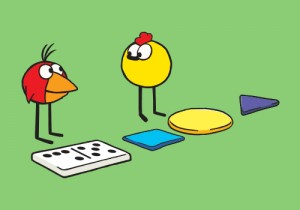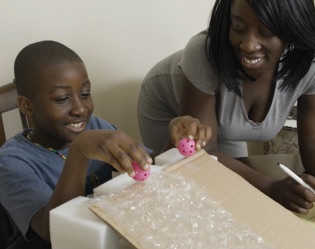
In many ways, the audience for PEEP and the Big Wide World is what you might expect. Every day, thousands of preschoolers, parents, and educators log on to this award-winning public media project to explore math and science—by watching videos, playing games, and finding hands-on activities they can explore in their own homes and neighborhoods. But PEEP’s audience is unique in one important way: more than 20% of PEEP’s users are Spanish-speaking. This wasn’t always the case. The growth of the program’s Spanish-speaking audience was a result of a deliberate campaign on the part of PEEP’s creators to reach out and connect with Hispanic children, who make up 25% of children under the age of 5 in the United States (U.S. Census, 2015), yet are consistently underserved when it comes to math and science programming.
What is PEEP?
Funded by the National Science Foundation, PEEP is a television series and website that stars a wide-eyed chicken named Peep, a robin (Chirp), and an irascible, endearing duck (Quack)—all of whom live in a large urban park, a place of endless wonder, adventure, and mystery. Animated stories highlight specific science or math concepts, and accompanying live-action videos depict real kids playing and experimenting with these concepts. Games and apps further reinforce the science and math ideas. Extensive materials for educators (curricular and professional development resources) support PEEP’s use in preschool classrooms and family childcare settings.
Gaining traction among Hispanic audiences
PEEP first attracted the attention of Hispanic families in the US when Spanish-language episodes began airing across the country through a partnership with V-Me, a Spanish-language, public television programming service. We posted a selection of these videos, along with translated hands-on science activities for families, to the PEEP website. Over time, we found that traffic to the several of the Spanish-language pages was nearly double that to the corresponding pages in English. This was the first concrete evidence we had that there was a real need for Spanish-language preschool science resources—and that PEEP could help fill it.
Digging into the issue, PEEP producers became aware of research showing that Latino children often lag behind non-Latino children on academic achievement tests. We learned that although parents can play a critical role in encouraging and supporting children’s science learning, many Hispanic and Latino parents are unsure how to support children’s science exploration. Language issues can post a major barrier – according to a 2013 Pew Hispanic Center report, only 68% of Hispanics in the US report that they speak English proficiently.
Motivated by this research, and inspired by the positive response to our existing Spanish-language resources, PEEP’s producers have taken many steps over the past several years to engage more deeply with Spanish-speaking families. Funded by the National Science Foundation, this work includes:
- Translating PEEP’s title and logo—the program is now known in Spanish as El Mundo Divertido de Peep.
- Debuting a new animated character, Splendid Bird from Paradise, who speaks a mix of English and Spanish and models how to make a home in a new place.
- Featuring native Spanish-speaking parents in PEEP’s live-action videos.
- Relaunching our website as a completely bilingual site, with all materials available in both English and Spanish, designed so that users can switch between languages whenever they desire.
- Identifying and consulting with a native Spanish-speaking science advisor.
- Launching an outreach initiative designed to evaluate best practices when engaging Latino families in informal science education. This included working with five model communities: San Antonio, Phoenix, Raleigh-Durham, Yakima Valley (WA), and Salt Lake City, in which the public television station and its partners hosted PEEP family events, trained preschool educators, and disseminated materials. Events were designed to coincide with El Dia de los Niños, a national day of celebration of Latino children.
- Reaching out to a new audience of family child care educators—people who care for children in their own homes—and creating curricular and professional development resources in both English and Spanish. (According to the National Association of Child Care Resource and Referral Agencies, almost half of Latino children under six are in some type of non-parental care on a weekly basis.)
- Connecting with partners who serve Spanish-speaking audiences and promoting the use of PEEP’s resources among their members. These include AVANCE, Head Start (particularly their Abriendo Puertas and Migrant/Seasonal programs), National Association for Family Child Care, Center for Advancement of Hispanics in Science and Engineering, National Association of Bilingual Educators, and the Aprendiendo Juntos Council.
- Establishing a Spanish-language YouTube channel and Facebook page, staffed by a native Spanish speaker.
- Raising awareness of PEEP’s resources among Spanish-speaking families by launching a promotional campaign with Latina bloggers.
Results
Immediately after the re-launch of the PEEP website as a fully bilingual site, we noticed a surge in the number of visitors to the Spanish-language pages. Today, a little over a year later, more than one-fifth of PEEP’s total visitors are Spanish-speaking. Our Spanish-language YouTube channel has also grown significantly, with subscribers up 81% from 2014-2015. In addition, Hispanic families have been vocal about their enthusiasm for PEEP: comments on social media over the last year include Me gusta Peep, Chrip y Quack! Quack esta un pato loco! (I like Peep, Chirp, and Quack! Quack is a crazy duck!) and En casa nos encanta esta caricatura y que buenas ideas el combinarlo con el aprendizaje. (At home, we love this cartoon and the good ideas that it combines with learning.)
Most gratifying, summative evaluation suggests that Spanish-speaking children are learning from their interactions with PEEP. While previous evaluations had shown that PEEP helps children learn science and math, we had not assessed its impact specifically on Spanish-speaking families until this year. A recent summative evaluation conducted by Concord Evaluation Group with 200 Spanish-speaking families found that children who used PEEP were more likely than children who did not use PEEP to increase their math and science knowledge, interest, and curiosity. Additionally, 99% of children said they would watch/play with PEEP again. The same study showed that Spanish-speaking parents who used PEEP resources were significantly more likely than parents who did not use PEEP to find enjoyment exploring science with their children, improve their knowledge of how to help their children learn science concepts, and believe that it is their role to help their children learn science and math. Furthermore, 100% of parents reported that they would let their child watch/play with PEEP again.
New directions
PEEP is thrilled with the results of our efforts to reach Hispanic children and families—and our work is not yet done. We have several proposals in the works to expand both our library of Spanish-language media resources, and our outreach efforts to engage Spanish-speaking children, including efforts to target diverse, low-income parents participating in home visiting programs. Our ultimate goal is to bring PEEP’s brand of science and math learning—along with its lovable characters and gentle humor—to as many Spanish- and English-speaking families as possible.
- PEEP and the Big Wide World
- El Mundo Divertido de Peep
- English YouTube Channel
- Spanish YouTube Channel
- View the full report by the Concord Evaluation Group
Jessica Rueter Andrews is the Project Director for PEEP and the Big Wide World.





